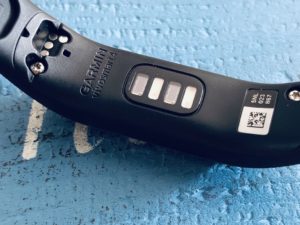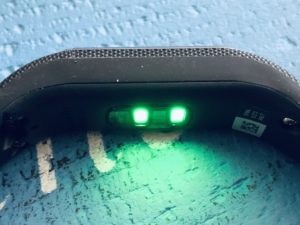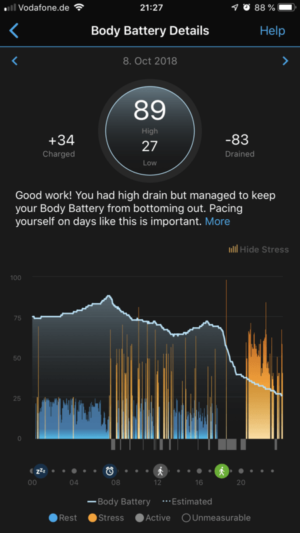The Garmin Vivosmart 4 is now officially the successor of the popular Garmin Vivosmart 3. We are currently testing it and are gradually taking a closer look at its everyday and fitness capabilities as well as its accuracy. Our first impressions of the new Vivosmart:
Garmin Vivosmart 4 Test: Conclusion (Preliminary)
What we like
- Wearing comfort, readability, operation
- Estimation of body energy reserves
- Notifications
- Precision
- Educational health information
What we don’t like
- Double tip not always reliable
- Band not exchangeable
The Vivosmart 4 is a versatile and uncomplicated activity tracker that not only offers the basic functions of a fitness wristband, but also some extras and implements them very well. However, if a larger display is important to you, you can also take a look at alternative models such as the Polar A370 or the Fitbit Charge 3.
Garmin Vivosmart 4: The Highlights
The Vivosmart 4 features all the features of a modern fitness band. The slim and waterproof wearable tracks the total number of steps for the day, the number of floors climbed, intensity minutes, daily calorie consumption and distance covered in kilometers.

It also displays the current heart rate in beats per minute (bpm) and the average resting heart rate for seven days, as well as weather data. For example, the current temperature and weather forecast from a paired smartphone. In addition, it has functions for the music player of the smartphone and displays notifications from the smartphone according to the notification settings of the smartphone. This includes calls, SMS messages, social network updates, and more. This is roughly equivalent to the standard equipment of a modern fitness band.
But what sets Vivosmart 4 apart from other trackers are the following new features, which we’ll discuss later in this article:
- Heart Rate Variability/Stress Level: Measuring heart rate variability (HRV) while inactive to determine stress levels with Pulse Ox Sensor: improved sleep analysis by means of an integrated pulse oximeter, which determines the oxygen saturation in the blood. This could help to detect sleep apnea.
- Body Battery Energy Balance: calculates the current energy budget based on HRV, sleep, stress and activity data.
It has a battery life of up to 7 days and a water resistance of up to 50m (5 ATM), which allows it to be worn while swimming. However, intensive dives should be avoided. Thanks to its slim design, the Wearable is extremely suitable for use in all conditions. Even at night, it hardly bothers you if you want to wear it while you sleep. So the wearable can do its work 24×7 in peace.
Test Operation and Available Pages
For our Garmin Vivosmart 4 test we created a small video about the operation and available data pages:
Below the display there is a softtouch key, which leads to the main menu or to the start menu. Unfortunately, there is no tangible, physical key built in that would make the operation easier during the sport.
The Display
In the pictures, the display looks bigger than it actually is in practice, as our Vivosmart 4 test shows. The display is rather small. But the readability doesn’t suffer from it. Garmin has managed to make the displayed characters and symbols large enough. In addition, the display is crystal clear. This means that the device has a sharp display and is very easy to read. Even in bright environments, such as sunny weather outdoors, the display remains easy to read.
Compared to its predecessor, the display has been clearly improved. But if a larger or colored display is important to you, you’ll have to look around for the competition, for example the Polar A370 or Samsung Gear Fit 2 Pro. Because they offer slightly larger and brighter displays.
The predecessor Vivosmart 3 is partly difficult to access via the display. However, the new model is easy to use and works reliably. See the video above. However, the display can hardly keep up with the two competitors mentioned above.
Accuracy & Reliability
So far we like the results of our test very much. Upstairs and downstairs floors with at least 10 steps per floor are correctly recorded. The sleep tracker also accurately records sleep and standing times. MoveIQ detects walks from 10 minutes (adjustable) automatically and enters these as activity in the app.
The stress level function also seems to do a good job. It recognized stressful working hours and offered a relaxation exercise in the form of breathing exercises. If you start the exercise, you will have to breathe in and out for a few minutes. Some people will know that when under stress and tension, breathing correctly and cyclically can have a very relaxing effect. For example, shortly before a lecture in front of an audience or in discussion rounds.
The Bluetooth connection to our iPhone 8 Plus with iOS 12 is stable. All notifications, reminders and alarms are immediately shown on the Vivosmart 4 display. The user is made aware of new messages via vibration.
The new pulse oximetry function
The integrated pulse oximeter (Garmin Pulse Ox sensor) measures the oxygen content in the blood directly at the wrist during sleep.
The Garmin Vivosmart 4 is the second Garmin Wearable after the Fenix 5 Plus sports watch to offer this feature. The sensor in the Fenix 5 Plus is also interesting for height-intensive sports. With the Vivosmart 4, the pulse oximeter pursues different goals. It is more about recognizing sleep disorders. However, it is important to know that Garmin or the tracker does not provide any active information or a classification of the measured values. This is up to you or a doctor, to whom you can show the determined graphs.
So you have to deal with the SpO2% values a little bit. It is important to observe the long-term trend, which can be read in the app. Individual measurements can also have fluctuations, see next paragraph. In order to use this feature sensibly, the wearable should be worn daily.
Garmin also points out that the Pulse Ox data is not intended to be used for medical purposes, nor is it intended to diagnose, treat, cure, or prevent disease. In addition, the accuracy of the measurement depends on a number of factors. These include the fit of the device and the presence of ambient light that can affect the readings. Excessive movement and the position of the device can also affect the accuracy of the readings. It is important to hold the arm/sensor still for about one minute for optimal accuracy.
The New Body Battery Function
The Vivosmart 4’s new Body Battery function is designed to help you keep track of your personal energy level. The Garmin Vivosmart 4 is the first Garmin Wearable with this function. It analyzes data on heart rate variability, stress levels, sleep quality and activity. From this, an index (Body Battery Index) is determined, which is shown on the display similar to a fuel gauge in a car. It should represent available energy reserves.
The Body Battery Reserves are indicated on a scale from 0 to 100. 0 to 25 stand for low energy reserves, 26 to 50 for medium energy reserves, 51 to 75 for high energy reserves and 76 to 100 for very high energy reserves. So the wearer should be able to estimate whether a training is still worthwhile or the body is not too tired and one should rather recover a little.
The following screenshot from the app shows that the Body Battery feature works properly. It shows a more intensive sports unit in the evening and how it is classified by Body Battery. The battery curve points further down:
So you have consumed a lot of energy this evening. In order to recharge the battery for the next days a good sleep, less activities and less stress is necessary. Unfortunately, diet is not included in the calculation because the Vivosmart 4 does not know what you have eaten during the day. You therefore have to pay attention to your diet yourself.
What Else We Have Noticed
Our Vivosmart 4 review is still in progress. We will take a closer look at the wearable in the next few weeks and then draw a final conclusion. What we noticed positively at the moment is that the display brightness and vibration intensity can be adjusted. Changing the settings also leads to visible/noticeable changes. The display also has an auto mode that adjusts the brightness to the lighting conditions.
The unit also has an alarm option for abnormal heart rates. This allows the device to be set to sound an alarm when the heart rate exceeds a predetermined threshold after a period of inactivity. This means, for example, that if you rest and your heart rate is too high (above the set threshold) for a prolonged period of time, the device will sound an alarm.
What we have noticed negatively at the moment is that you can’t quickly see how full the battery is. Furthermore, the double-tap gesture for waking up the display does not seem to be reliably recognized. The display is activated automatically and correctly when the arm is moved, but if you want to wake it up with a double tap, this won’t always lead to success. Maybe we still have to find out the right typing intensity or speed.
All in all, we like the Tracker very much so far. It is unobtrusive, reliable and versatile.
Vivosmart 3 or Vivosmart 4?
Compared to its predecessor, the Vivosmart 4 has not only become slimmer, but also has many similarities and some changes. The most noteworthy ones can be seen in the comparison table below. If you are interested in the predecessor, we have this extensive Vivosmart 3 review.
| VIVOSMART 3 | VIVOSMART 4 | |
|---|---|---|
| Puls oximeter | No | Yes |
| Body Battery-Energiemonitor | No | Yes |
| Activity log on the clock | Yes | No |
| Tracking functions for children: Toe-to-Toe-Challenges | No | Yes |
| Waterproof | 50 Meter (5 ATM) | 50 Meter (5 ATM) |
| Display size | 9,6 x 19,2 mm | 6,6 x 17,7 mm |
| Display resolution | 64 x 128 Pixel | 48 x 128 Pixel |
| Weight |
|
|
| Amazon | Product link | Product Link |
Buy, Price & Availability
The Vivosmart 4 is already available on the market. You can choose between the wristband sizes S/M and L. The band is unfortunately not exchangeable, so that one should consider well before a purchase, which variant really pleases.



